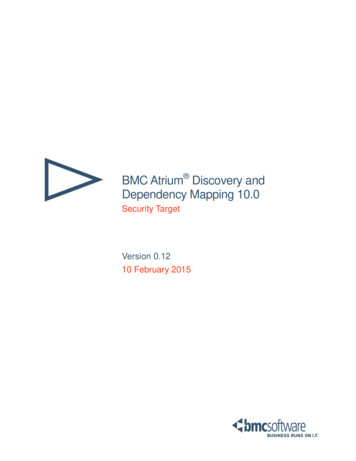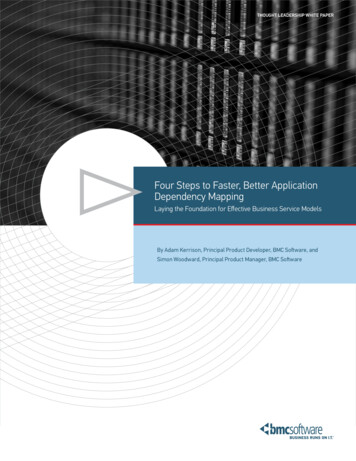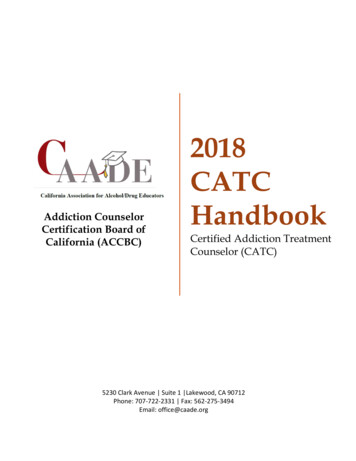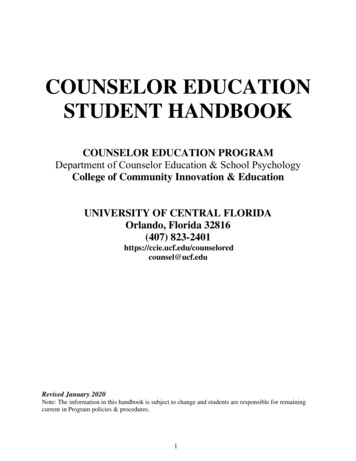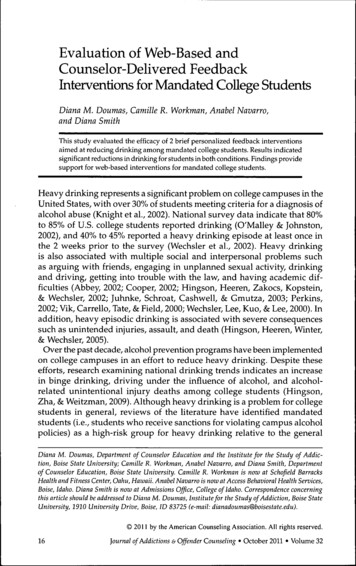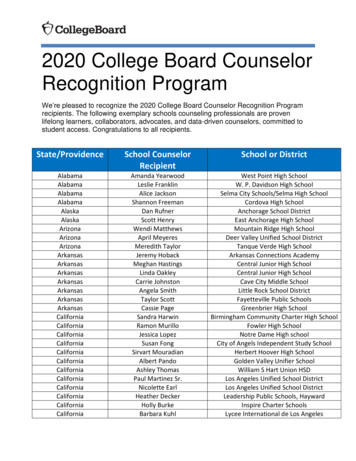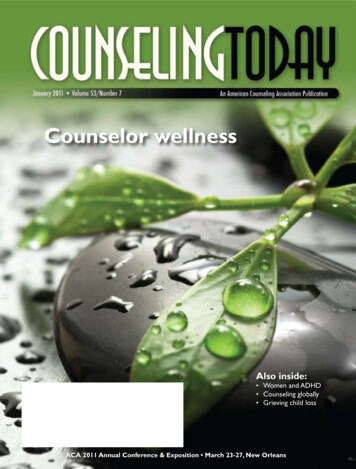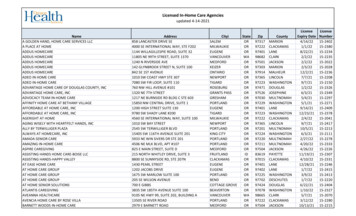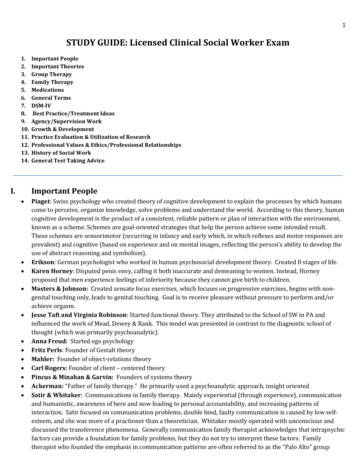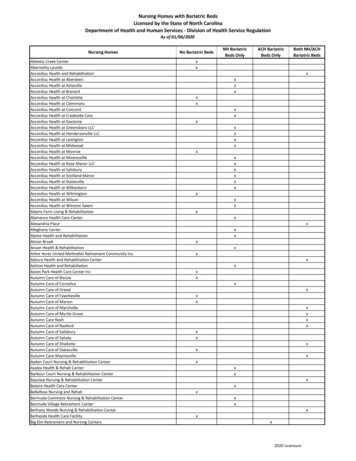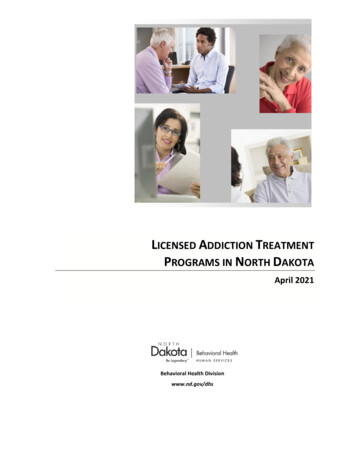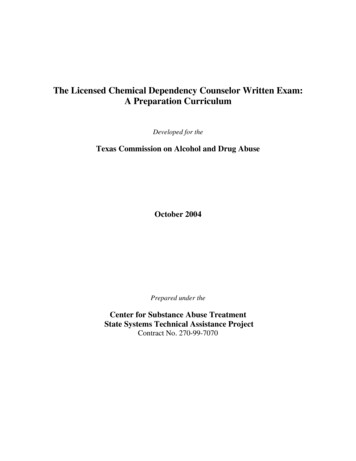
Transcription
The Licensed Chemical Dependency Counselor Written Exam:A Preparation CurriculumDeveloped for theTexas Commission on Alcohol and Drug AbuseOctober 2004Prepared under theCenter for Substance Abuse TreatmentState Systems Technical Assistance ProjectContract No. 270-99-7070
AKNOWLEDGEMENTS .I. INTRODUCTION. 1A.B.C.D.E.F.G.HOW TO USE THIS CURRICULUM . 1THE PURPOSE OF THE LCDC WRITTEN EXAM . 1DESCRIPTION OF THE WRITTEN EXAM . 1DESCRIPTIONS OF THE DOMAINS. 2SUGGESTIONS FOR EFFECTIVE STUDYING . 3SUGGESTIONS FOR TAKING THE EXAM . 4SUMMARY . 5II. ASSESSMENT . W OF ASSESSMENT. 6CULTURAL RELEVANCE . 6EXPLAINING ASSESSMENT TO CLIENTS . 6BIOPSYCHOSOCIAL PERSPECTIVE . 7ADDITIONAL ASSESSMENT SERVICES . 7INTERVIEWING CLIENTS . 7ASSESSMENT INSTRUMENTS . 8SCREENING INSTRUMENTS . 8COMPREHENSIVE MEASURES OF DRINKING . 9DIAGNOSTIC INSTRUMENTS . 10INSTRUMENTS TO AID TREATMENT PLANNING . 10INSTRUMENTS THAT MEASURE OTHER CONSTRUCTS . 11PHYSIOLOGICAL MEASURES . 11ASSESSING FOR SUICIDE RISK . 12ASSESSING READINESS FOR CHANGE . 12ASSESSING FAMILIES . 12THE DSM-IV-TR. 13DIAGNOSING SUBSTANCE ABUSE AND SUBSTANCE DEPENDENCE . 14THE WRITTEN ASSESSMENT SUMMARY . 16TREATMENT PLANS. 17SUMMARY . 18III. COUNSELING. 20A.B.C.D.E.F.G.CLINICAL SKILLS USED WITH MANY COUNSELING APPROACHES . 20TYPES OF AVAILABLE TREATMENT . 21GROUP COUNSELING. 22CRISIS INTERVENTION AND SUICIDE . 25THEORIES OF COUNSELING . 27THE INTERVENTION PROCESS . 48THE THERAPEUTIC COMMUNITY . 50IV. CASE MANAGEMENT. 52A.B.C.D.E.F.G.H.I.J.INTRODUCTION . 52THE FUNCTIONS OF CASE MANAGEMENT . 52MODELS OF CASE MANAGEMENT . 52PRINCIPLES OF CASE MANAGEMENT. 53THE TREATMENT CONTINUUM . 53CASE MANAGEMENT IMPROVES OUTCOMES. 54COMMUNITY RESOURCES . 55ADVOCACY AND COORDINATION IN CASE MANAGEMENT . 55CULTURALLY SENSITIVE CASE MANAGEMENT . 55CASE MANAGEMENT WITH WOMEN . 55
K.L.M.N.CASE MANAGEMENT WITH ADOLESCENTS . 56DOCUMENTATION OF CASE MANAGEMENT ACTIVITIES. 56EVALUATING CASE MANAGEMENT EFFECTIVENESS . 56SUMMARY . 56V. CLIENT, FAMILY, AND COMMUNITY EDUCATION. 57A.B.C.D.E.F.G.H.I.J.ETIOLOGY OF SUBSTANCE RELATED DISORDERS. 57HOW SUBSTANCE ABUSE/DEPENDENCE ARE PREVENTED . 58THE TREATMENT AND RECOVERY CONTINUUM. 59EFFECTS OF ALCOHOL/DRUGS ON THE FAMILY . 61PHYSICAL HEALTH RISKS ASSOCIATED WITH ALCOHOL/DRUG USE . 62A DESCRIPTION OF SEVERAL SELF-HELP GROUPS . 66PHARMACOLOGY—SPECIFIC EFFECTS OF DRUGS ON THE BODY . 70ROUTE OF ADMINISTRATION . 72MOTIVATION FOR DRUG USE . 73CLASSIFICATION OF DRUGS . 74VI. PROFESSIONAL RESPONSIBILITY. 81A.B.C.D.E.F.G.H.I.J.K.L.M.N.O.P.Q.INTRODUCTION . 81ETHICS . 81DECISION-MAKING MODELS . 81FUNDAMENTAL ETHICAL PRINCIPLES . 81THE NAADAC PRINCIPLES . 82ETHICAL STANDARDS . 82PROMOTING CLIENT RIGHTS . 82NONVOLUNTARY CLIENTS . 84RESPECTING CLIENT DIVERSITY . 84PROFESSIONAL DEVELOPMENT . 85CONTINUING EDUCATION . 85SELF EVALUATION . 85SUPERVISION . 86CONSULTATION . 86REFERRALS . 86ADVOCACY . 87SUMMARY . 87VII. SUGGESTED READING LIST. 88A.B.C.ADAPTED IC&RC READING LIST . 88SUGGESTED READING . 89VIDEO AND PRACTICE TESTING MATERIALS . 91VIII. REFERENCES. 92
AknowledgementsThe authors:Edwin R. Bergen, Ph.D., LPC, LCDCCoordinator, Mental Health Technology ProgramSan Antonio CollegeKathryn Miller, Ph.D., LPC, LCDCAssociate ProfessorSan Antonio Collegewould like to thank the following individuals who generously provided guidance, inputinto the content of the manual, and professional assistance by serving as reviewers:Gerhard E. Carrier, Ph.D. LPC, LMFT,LCDCChairman, Department of Mental Healthand Addiction StudiesAlvin Community CollegeElizabeth Coccia, Ed.D., LCDCProfessor, Human ServicesAustin Community CollegeFrank Davis, LCDC, AACProgram DirectorCivigenicsRobby DuffieldManager, Licensing and CertificationTexas Commission on Alcohol and DrugAbuseGloria Hart-Jackson, MA, LCDCChair, Social Work/Substance AbuseProgramEastfield CollegeKristine Kostoff, LMSW, LCDCFormer Manager, Counselor LicensureDepartmentTexas Commission on Alcohol and DrugAbusePhil OrrickProject ManagerGulf Coast Addiction Technology TransferCenterE. Don Poage, M.A., LPC, LCDCAlcohol and Drug Abuse CounselingProgram DirectorMidland CollegeRich Rosing, M.S. Rehab CN, LCDCDepartment ChairHuman Service Technology ProgramHouston Community CollegeMark Sanders, LCSW, CADCTrainer and ConsultantSanders & Associatesi
I. IntroductionA. How to Use This CurriculumTaking the Licensed Chemical Dependency Counselor (LCDC) written exam is animportant milestone in a counselor’s career. This curriculum is designed to summarizethe large body of knowledge to which LCDC candidates have already been exposedthrough formal education and training or self study. The curriculum may be used forindependent self-study, to facilitate discussion in study groups, or as the basis of exampreparation workshops.The purpose of this curriculum is to reinforce previous learning, reminding candidates ofwhat they already know. It is a tool for systematically reviewing the material anddetermining what content areas have been mastered sufficiently and which ones requiremore study. Candidates are encouraged to carefully read the curriculum a few paragraphsor pages at a time, highlighting important terms and making notes in the margins.Discussing the material with others and using the resources in the suggested reading listcan provide clarification when needed.A secondary purpose of the curriculum is to level the field for candidates who may havegaps in their knowledge for not having been exposed to a thorough, systematic programof study, or whose coursework was completed some time ago. While we hope that thiscurriculum will be a valuable tool for preparing for the written exam, it is not intended totake the place of conscientiously completing a high-quality counselor preparationprogram.B. The Purpose of the LCDC Written ExamThe State of Texas licenses chemical dependency counselors, as it does otherprofessionals, in order to meet its responsibility to protect consumers from harm inflictedby unqualified practitioners. It does this by assuring that new counselors have metminimal competency requirements. That is, the exam samples the information that newcounselors are expected to know, not everything that a seasoned counselor should know.Counseling is both rewarding and difficult work. By requiring that new counselorsdemonstrate a solid foundation of the appropriate knowledge, the licensing exam actuallyhelps to set up counselors for success. Therefore, rather than view the exam as a barrier tobe overcome, view it as a bridge. There are steps to cross it, and the reward on the otherside is worth the effort.C. Description of the Written ExamThe LCDC written exam administered in Texas is the same exam given in most of theUnited States, as well as internationally. The International Certification and ReciprocityConsortium (IC&RC) contracted with a professional testing company to develop theexam based on a recent study of what alcohol and other drug counselors actually do. The1
Texas Certification Board of Addiction Professionals (TCBAP) is responsible foradministering the exam in Texas. Candidates may download application forms for testingand access exam results from TCBAP’s Web site (www.tcbap.org). Candidates willautomatically receive their results through the mail. This report includes the total score,and scores for each content domain: Assessment, Counseling, Case Management, Client,Family and Community Education, and Professional Responsibility.The written exam consists of 150 multiple-choice items, each with five answer options.Candidates have 3 ½ hours to complete the exam by marking the best answer for eachitem on a separate answer sheet. The raw score, the number of correctly answered items,is statistically converted to a scaled score, which ranges from 200 to 800 points. Apassing score is 500 or more scaled points.The written exam is constructed by selecting items from a large pool of items called anitem bank. Candidates do not know beforehand specifically how items will be worded.Each administration uses a version of the exam with the same blueprint. Each version ofthe written exam is statistically adjusted to be of the same difficulty level. Therefore,each candidate takes an exam with the same number of items per domain and of equaldifficulty.D. Descriptions of the DomainsThe Assessment domain (37 items; 24 percent of the exam) includes items regardinginterview techniques, diagnosing substance related disorders and recognizing co-existingdisorders, treatment planning, and knowledge of specific alcohol and other druginstruments.The Counseling domain (40 items; 27 percent of the exam) includes items regardingbasic counseling skills, counseling modalities and strategies, counseling theories, relapseprevention, and documenting counseling activities.The Case Management domain (23 items; 15 percent of the exam) includes itemsregarding matching clients to community resources and services, referral procedures,consultation procedures, client advocacy, evaluating case management effectiveness, anddocumenting case management activities.The Client/Family/Community Education domain (16 items; 11 percent of the exam)includes items regarding communicating information to individuals, families andcommunities about the biological, emotional and behavioral effects of alcohol and otherdrug use, and educating others about prevention and treatment.The Professional Responsibility domain (34 items; 23 percent of the exam) includesitems regarding codes of ethics, promoting client rights, professional development,relating effectively with other professionals, cultural competence, professionalorganizations, and counselor self awareness.2
E. Suggestions for Effective StudyingThere are two main reasons that an examinee may not perform as well as desired on thistype of exam. One is insufficient mastery of the material, and the other is difficulty withthe examination process itself. Both sources of difficulty are preventable.Study strategies that work best for one person may not work best for another. Studystrategies make sense when they suit an individual’s particular learning style, allowenough time for deep learning, and are something with which the person can followthrough. Some study strategies that are sound for all examinees for the LCDC writtenexam follow: Aim for quality of study time, not just quantity. Information makes it intolongterm memory when it is processed deeply; that is, its meaning is understood.This is more effective than rote memorization, particularly for large quantities ofmaterial, some of which is complex. It is more efficient to spend 1 thoughtfulhour on learning material than 5 hours repeatedly skimming it. Studying to learn,not just memorize, is wise. Study the right material. While the exam items themselves are kept secure, thegeneral topics that are covered by the exam questions are not a secret. Candidatesmay use this curriculum to help focus their study efforts. It is wise to balance theattention given each area of the exam. For example, it would be a poor strategy tospend time becoming an expert on 10 different counseling theories if that resultedin neglecting other important topics. Avoid complacency. Knowledge of the 12 core functions and experience as aperson in recovery are insufficient to prepare a candidate to pass the examination.Working in the field is probably insufficient, because the written exam tapsknowledge more than skills, and performing a skill is not the same asdemonstrating knowledge of that skill. For example, examinees do notdemonstrate their interviewing skills on the licensing exam. However, they mightbe asked to recognize the advantages of using motivational interviewing oridentify an appropriate counselor reflection statement. Make a reasonable study plan. An organized approach will make preparing forthe exam a manageable task. Divide the material into topics. Study only one topicper study session, and, if possible, only one topic per day. Study for small blocksof time (1 or 2 hours) over several weeks. Studying small chunks of material overa longer period of time, called distributed practice, results in better learning thanmassed practice, also called cramming. People who say that they perform well onexams when they cram probably already knew the material before their cramsession. If one has already learned the material, looking over it again at the lastminute will not hurt. But waiting until the last minute to learn new material is arisky strategy.3
Make emotions work for you. Some nervousness in anticipation of taking alicensing exam is normal and can provide energy that can be directed towardpreparing for it. Note that normal nervousness does not have to becomeuncomfortable anxiety. Appropriate self-messages, such as, “I have every reasonto expect to perform well on this task,” and “My conscientious study and goodattitude are preparing me adequately for this task” can help turn anxiety intopositive anticipation. Keep a positive attitude. Focus on positive messages from yourself and others.Some appropriate self-messages are “I am not going to be asked about everythingin the drug and alcohol counseling field,” “I do not have to answer 100 percent ofthe items correctly,” and “This is only one of many challenges that I have met andwill meet in my career.” Keep in mind that any negative messages that you mayhear from other people arise from questionable motivation and are certainlyunhelpful. Join a study group—maybe. Depending on one’s learning style, a study groupcan be enjoyable and helpful, or a tiresome distraction. The composition of astudy group also matters. Study group members who are somewhat evenlymatched as far as overall level of knowledge and motivation tend to work best.Otherwise, there is a risk of some members engaging in “social loafing” andletting others do most of the work. Practice answering multiple-choice items. Multiple-choice items have their ownspecial structure and a particular rhythm to their wording. While the actual examitems are kept secure, practice items addressing similar content are availablecommercially in print format and on compact disk. Familiarity with answeringthis type of question can make the exam go more smoothly.F. Suggestions for Taking the ExamTo perform well on the exam, it is necessary not only to have mastered the material butalso to know how to test well. Some suggestions follow: Take care of physical needs the day of the examination. Sleep well the nightbefore, eat well, and arrive for testing early enough so that there is time to relax afew minutes before being called to test. Expect items to be interspersed according to difficulty level and domainrepresented. On the exam, items do not become progressively easier or moredifficult. All of the assessment items are not clustered together, followed by theprofessional responsibility items, etc. Read each item carefully and completely before answering. Words like “best,”“first,” and “except” in the stem of the item can make all the difference in4
determining the correct answer. Read through all of the answer choices. Only oneis the best answer. The other four choices, called distractors, are there to pullexaminees’ attention away from the best answer. Do not spend several minutes on one item. Move along, and come back to itemsthat require more thought, if needed. Choose the best answer of those provided. Another correct answer may exist butis not one of the choices. This does not mean that this is a trick question. Make educated guesses if needed. Even if an examinee is unsure of the bestanswer, there are usually some answer choices that can be eliminated. The advice,“when in doubt, choose C,” does not apply to professionally developed exams,and therefore does not apply in this situation. Each item should be answered,since there is no penalty for guessing. Remember that exam items reflect current knowledge as described in thealcohol and other drug counseling literature. The correct answer to some itemsmay or may not resemble an examinee’s opinion or how things are done wherethey work. For example, an examinee may believe that treatment for a substancerelated disorder should take place before treatment for a co-occurring disorder.However, the generally accepted treatment standard is concurrent treatment for alldisorders.G. SummaryPreparing for the LCDC Written Exam can be a challenging and enjoyable task,particularly if candidates appreciate the reasons behind taking the exam and adopt apositive attitude toward the process. To perform well on the exam, it is useful to knowsomething about its structure and to be familiar with answering multiple-choice items. Itis also important to carefully review the topics represented on the exam. This curriculumis designed to help candidates focus their study efforts, thereby helping them cross thebridge to licensure as a chemical dependency counselor.5
II. AssessmentA. Overview of AssessmentAssessment is an ongoing process through which the counselor collaborates with theclient and others to gather and interpret information necessary for planning treatment andevaluating client progress (CSAT, 2002, p. 35). Tools of assessment include counselors’observations, clinical interviews, laboratory tests, and instruments such as tests and selfreport inventories.Interviews with other people in the client’s life can corroborate client self reports. Familymembers may provide information about a client’s developmental history, earlyattachments, and how the client fit into the family. Other sources of information arefriends, staff, school records, and physicians. Appropriate documentation of clientconsent is required before counselors can solicit information from outside sources.B. Cultural RelevanceAssessment should be culturally relevant, taking into account the client’s social context.A behavior may carry a meaning in the client’s culture that is different from that of thecounselor’s culture. For example, communicating with a deceased loved one mightindicate complicated mourning to a counselor with a certain view of death, while to aclient with a different view, it is an accepted method of continuing a relationship with aloved one who will be seen again in time. In this case it would be inappropriate tointerpret the client’s behavior as pathological, particularly since it caused the client nosubjective distress.Counselors should also be aware that culture influences how clients report theirdifficulties. For example, some clients may report somatic symptoms such as stomachupset or headache, and these are actually indicative of depression (Watkins, Lewellen &Barrett, 2001, p. 69). Clients may have ways of expressing their distress that areparticular to their culture. Counselors may want to become familiar with the idiomaticexpressions used by the clients with whom they frequently work. Examples of suchexpressions used by some Spanish-speaking clients are ataque de nervios, mal de ojo,locura, and susto (American Psychiatric Association, 2000, p. 898-903).C. Explaining Assessment to ClientsClients need to know the procedures being used in their assessment, and they need tohave an opportunity to ask questions about them. They need to know that the purpose ofthe assessment is to gather information that will help determine the counselinginterventions that will be most helpful to them. Clients are likely to cooperate with theassessment process if rapport has been established and the reason for the assessmentprocedures is clear.6
When explaining assessment results to clients, counselors should use nontechnicallanguage that the client understands. The counselor should offer results not as aproclamation but tentatively for the client’s consideration. For example, “What this scoresuggests is that you may have alcohol dependence” is preferable to “According to thistest, you are an alcoholic.” Clients should have an opportunity to ask questions andindicate their level of agreement with the assessment results.D. Biopsychosocial PerspectiveThe biopsychosocial perspective recognizes that there are biological, psychological, andsocial causes of substance abuse and dependence. Biological factors include brainchemistry problems, which may be genetic. Genetics influence biochemistry, andbiochemistry makes some people particularly vulnerable to addiction to certain drugsonce they try them. Psychological factors include cognitive styles, personality traits, andearly developmental experiences. Social factors include poverty, oppression, poorlydeveloped social skills, and family dysfunction (Watkins, et al., 2001, p. 3). Counselors’assessments emphasize psychological and social factors.A psychosocial assessment will produce information on clients’ presenting problems,alcohol and other drug use, psychiatric and chemical dependency treatment, medicalhistory and current health status, relationships with family, social and leisure activities,education and vocational training, employment history, legal problems, mental/emotional functioning, and strengths and weaknesse
The LCDC written exam administered in Texas is the same exam given in most of the United States, as well as internationally. The International Certification and Reciprocity Consortium (IC&RC) contracted with a professional testing company to develop the exam based on a recent study o
